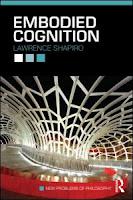 'Embodied Cognition', by philosopher Lawrence Shapiro, is not a book advocating for any particular brand of embodiment. Instead, Shapiro has performed an invaluable service and written an overview of the current state-of-the-art in embodied cognition. The book is though, even-handed, and not afraid to highlight key successes and failures of embodied cognition's attempts to take over the world of cognitive science.
'Embodied Cognition', by philosopher Lawrence Shapiro, is not a book advocating for any particular brand of embodiment. Instead, Shapiro has performed an invaluable service and written an overview of the current state-of-the-art in embodied cognition. The book is though, even-handed, and not afraid to highlight key successes and failures of embodied cognition's attempts to take over the world of cognitive science.Shapiro was recently featured on a Brain Science Podcast which is well worth a listen. He can be found online at his website.
Shapiro starts out with a description of what standard cognitive science is, so that we can evaluate theories that claim to compete with it. He identifies that the standard approach is computational, and that mental processes do their work by manipulating symbols with algorithms that take perception as input and output behavior. He then briefly summarises the two main challengers to this account of cognition, Gibson's ecological psychology and connectionism. Gibson worked hard (and successfully) to demonstrate that much of the work of visual perception is not done 'in the head', while connectionism showed how to solve cognitive problems with non-symbolic, distributed systems. Shapiro treats these as the first real attempts to answer the question, 'if not symbolic representation, then what else could it be?', and the basic insights from these programmes are spread throughout embodied cognition
Shapiro then splits current approaches to embodiment into three streams: the Conceptualisation hypothesis, the Replacement hypothesis, and the Constitution hypothesis. He reviews work in each stream and evaluates each as a challenger to the standard approach separately.
Conceptualisation
This is broadly the hypothesis that the way we conceive of the world depends on the form of our bodies. Examples include
- the way we experience color comes from how our color detection systems interact with light (Varela, Thomson & Rosch, 1991)
- the way we form and understand the metaphors that ground our conceptualisations is shaped by our bodies (Lakoff & Johnson, 1999)
- the way we understand abstract concepts such as time are grounded in embodied experiences of things such as space (the past is behind, or up; Boroditsky, 2001)
- the meaning of amodal symbols is grounded in model symbols from our perceptual systems (Barselou, 1999; Glenberg & Kaschak, 2002).
Replacement
Work in this stream claims that computational approaches to cognition are inherently flawed, and should be replaced with dynamical, ecological descriptions. After reviewing the classic example of the Watts steam governor (van Gelder, 1995) Shapiro talks about some of the exemplar research in this area, including
- categorical perception using embodied neural networks (Beer, 2003)
- robotics work (especially the pioneering work from Rodney Brooks (e.g. Brooks 1991)
Constitution
This stream is mostly organised around Clark & Chalmers (1998) hypothesis of the extended mind. Work in this area is mostly theoretical and philosophical, and consists of heated arguments about whether things outside the brain are genuinely parts of cognitive processes, or whether they simply cause a cognitive process to happen. The key work reviewed here, besides Andy Clark's book Supersizing the Mind (2008) is
- sensorimotor theories of perceptual experience (O'Regan & Noë, 2001) that claim we experience the world the way we do because we learn the various contingencies between how we move and how perceptual information changes as a result - a ball looks like a ball because it looks a certain way as we move our eyes)
- the role that gesture seems to play in language - not merely augmenting the core meanings of speech, but a key player in communication (e.g. Ehrlich et al, 2006)
Summary
Overall, this is an excellent resource and a handy reference for a debate that is happening across multiple literatures (in psychology, robotics, philosophy and more). Shapiro provides a clear overview of the state of the art, and is basically correct in his various evaluations of where things stand. This will stand for some time as a key resource, and I would use the hell out of it as a core text for a course on embodied cognition.
I was also interested to note that the research I typically point to as not-really-embodied-cognition does not feature in this book. At best, this work might fit under the banner of the Conceptualisation hypothesis, which does not come out well as a competitor to the standard approach or even as a workable scientific approach. I'm treating this as another nail in the coffin I'm building for this research.
A take home note
I was depressed by one thing in this book: the degree to which vast amounts of embodied cognition work consists of arguing about thought experiments. Does Otto really remember things using his notebook the way Inga does with her brain? Just what would those floating spheres know about 'forwards' or 'up'? What about all those brains in vats and the incredible things scientists can apparently do to them? For the love of science, people, give it up. You end up arguing about the details of things that do not (and possibly can not) exist, rather than the thing we're actually interested in - how cognition is actually implemented in us. Embodied cognition will never get anywhere without working with real systems and figuring out whether they are embodied or extended.
References
Shapiro, L. (2011) Embodied Cognition. NY: Routledge Press Amazon.co.uk

